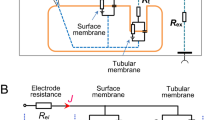Abstract
In search for a rapid and reliable method to identify and quantitatively determine cell membrane resistances and paracellular shunt resistances in epithelia we have developed appropriate techniques to measure transepithelial and intracellular potential transients in response to transepithelially applied square wave constant current pulses. Model considerations indicate that in a unilayered, homogeneous epithelium with open lateral spaces the transient potential response across each cell membrane should obey a single exponential function in case the tight junction resistance is high, as in a tight epithelium, whereas in a leaky epithelium it should consist of a superposition of two exponentials with equal sign at the membrane with the higher intrinsic time constant and of two exponentials of different sign (overshoot with recline) at the membrane with the lower intrinsic time constant. The latter predictions were experimentally verified in a study on Necturus gallbladder epithelium and equivalent circuit parameters for the cell membrane resistances and capacitances as well as for the resistance of the shunt path were calculated from the data by curve fitting procedures. The resistances of the apical and basal cell membrane and of the shunt path averaged 1220, 201 and 91 Ω cm2 respectively while the apical and basal cell membrane capacitances were 8.0 and 26.3 μF/cm2 respectively. The fact that the resistance values are 4–15 times lower than estimates derived previously from 2D-cable analysis relates to a better preservation of the transport function under the present incubation conditions as verified by a new series of cable analysis data. The capacitances agree well with estimates of the surface amplification of the cell membranes from electronmicrographs, thus confirming the validity of the interpretation of the observed voltage transients.
Similar content being viewed by others
References
Bindslev N, Tormey J McD, Wright E (1974) The effects of electrical and osmotic gradients on lateral intercellular spaces and membrane conductance in a low resistance epithelium. J Membr Biol 19:357–380
Bundgaard M, Zeuthen T (1981) The structure of Necturus gallbladder epithelium at low osmolarities. J Physiol (Lond) 316, 60P
Clausen C, Lewis SA, Diamond JM (1979) Impedance analysis of a tight epithelium using a distributed resistance model. Biophys J 26:291–318
Cole KS (1968) Membranes, ions and impulses. University of California Press, Berkeley
Frömter E (1972) The route of passive ion movement through the epithelium of Necturus, gallbladder. J Membr Biol 8:259–301
Frömter E, Gebler B (1977) Electrical properties of amphibian urinary epithelia. III. The cell membrane resistances and the effect of amiloride. Pflügers Arch 371:99–108
Frömter, E, Suzuki K Kottra G, Kampmann L (1981) The paracellular shunt conductance of Necturus gallbladder epithelium: comparison of measurements obtained by cable analysis with measurements obtained by a new approach based on intracellular impedance analysis. In: Macknight ADC, Leader JP (eds) Epithelial ion and water transport. Raven Press, New York, pp 73–83
Gögelein H, van Driessche W (1981) Capacitive and inductive low frequency impedances of Necturus gallbladder epithelium. Pflügers Arch 389:105–113
Gunther-Smith PJ, Grasset E, Schultz StG (1982) Sodium coupled amino acid and sugar transport by Necturus small intestine. J Membr Biol 66:25–39
Helman SJ, Nagel W, Fisher RS (1979) Ouabain on active transepithelial sodium transport in frog skin. J Gen Physiol 74:105–127
Higgins, JT, Cesaro L, Gebler B, Frömter E (1975) Electrical properties of amphibian urinary bladder epithelia. I. Inverse relationship between potential difference and resistance in tightly mounted preparations. Pflügers Arch 358:41–56
Kottra G, Rausch U, Frömter E (1981) Electrical equivalent circuit analysis of gallbladder epithelium. Pflügers Arch (Suppl) 391:R24
Lewis SA, Eaton DC, Diamond JM (1976) The mechanism of Na+ transport by rabbit urinary bladder. J Membr Biol 28:41–70
Lim JJ, Kampmann L, Frömter E (1980) Fast intra- and transepithelial impedance measurements across a leaky epithelium. Abstracts Biophysical Society Meeting New Orleans
Reuss L, Finn AL (1975) Electrical properties of the cellular transepithelial pathway in Necturus gallbladder. I. Circuit analysis and steady state effects of mucosal solution ionic substitutions. J Membr Biol 25:115–139
Reuss L, Finn AL (1977) Effects of luminal hyperosmolality on electrical pathways of Necturus gallbladder. Am J Physiol 232(3):C99-C108
Reuss L, Weinman StA, Grady TP (1980) Intracllular, K+-activity and its relation to basolateral membrane ion transport in Necturus gallbladder epithelium. J Gen Physiol 76:33–52
Schifferdecker E, Frömter E (1978) The AC impedance of Necturus gallbladder epithelium. Pflügers Arch 377:125–133
Schwan HP (1957) Electrical properties of tissue and cell suspensions. In: Lawrence JJ, Tobias CA (eds) Advances in biological and medical physics, vol 5. Academic Press, New York, pp 147–209
Suzuki K, Frömter E (1977) The potential and resistance profile of Necturus gallbladder cells. Pflügers Arch 371:109–117
Suzuki K, Frömter E (1978) Square wave pulse analysis of cell membrane impedance of Necturus gallbladder epithelium using shielded, low capacity intracellular microelectrodes. Proc VI Internat Biophysics Congress Kyoto, p 297
Suzuki K, Rohlicek V, Frömter E (1978) A quasi-totallyshielded low-capacitance glass microelectrode with suitable amplifiers for high-frequency intracellular potential and impedance measurements. Pflügers Arch 378:141–148
Weinman SA, Hamm J, Reuss L (1981) K+ and H+ transport across apical membrane of amphibian gallbladder epithelium. Fed Proc 40:A363
Author information
Authors and Affiliations
Rights and permissions
About this article
Cite this article
Suzuki, K., Kottra, G., Kampmann, L. et al. Square wave pulse analysis of cellular and paracellular conductance pathways in necturus gallbladder epithelium. Pflugers Arch. 394, 302–312 (1982). https://doi.org/10.1007/BF00583694
Received:
Accepted:
Issue Date:
DOI: https://doi.org/10.1007/BF00583694




